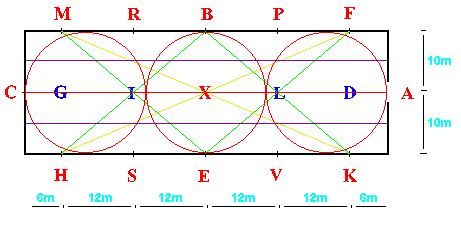Dressage is what many people would consider the Ballet of the horse
world. What appears beautiful and effortless to the audience is in fact an
achievement in art and athleticism requiring years of development and dedication for both
horse and rider. Dressage is performed in a 20 x 60 meter arena with a set of
letters that designate where movements are to be executed; the letters also assist the
rider in judging specific distances, such as the size of a circle. In addition,
lower level tests may also be adjusted and performed in what is referred to as the short
arena, which is 20 x 40 meters. For an explanation of terms used in Dressage and a
description of movements, click here or on the link above.

This diagram represents the standard (large) dressage arena. The small arena
removes the letters R, S, V, and P, and is only 40 meters long, with 14 m between the
letters, but maintaining the 6 m between the ends of the arena and the first
letters. The arena is traditionally formed by a low white fence or chain.
The three red circles are the three primary 20 m circles. The red line from C to A
is the centerline; the purple lines are the quarterlines. The long diagonals are
shown in yellow, and the short diagonals in green. In tests, the judge sits at C,
and there may be a second judge at E or B.
Dressage is trained and shown in specific levels which build on each other and which
reflect the development of the skills and abilities of both the horse and rider. The
tests ridden in shows are used as a measure of the correctness of the horse's (and
rider's) schooling. There are six standard levels (Introductory Level thru Fourth Level)
and four International levels (Prix St George, Intermediaire I and II, and Grand
Prix). Tests are prepared and distributed by USA Equestrian,
and are rewritten every few years.
Each level has a specified purpose which is stated on the test form. In addition,
each movement in the test has a description of what the movement is and what elements are
needed to perform it correctly. Scoring for the tests is based on both individual
movements and collective marks. In addition, certain movements have coefficients
that make them more important. The scoring scale is as follows:
10-Excellent, 9-Very good, 8-Good, 7-Fairly good, 6-Satisfactory, 5-Sufficient,
4-Insufficient, 3-Fairly bad, 2-Bad, 1-Very bad, 0-Not performed
The collective marks are based on:
Gaits--the freedom and regularity of the horse's movement
Impulsion--the horse's desire to move forward, elasticity of steps, roundness
Submission--the horse's attention and confidence, harmony with rider, lightness
of movements, and acceptance of the bit
Rider's position and seat--correctness and effect of the aids
Following is a breakdown of the lower levels and what is expected for proper performance
and proficiency at that level. (For information on the Intermediate
and International levels, click on the links to those
pages.) A riding whip, not to exceed 48" including the lash, and spurs are
allowed and/or required at all levels, though spurs are usually not used in Introductory
level work; spurs are optional through Prix St George, but mandatory for Intermediaire and
above. A snaffle bridle is used in the AHSA levels (Introductory through Fourth
Level), and a double bridle is used in the International levels (Prix St George through
Grand Prix). The double bridle may be used optionally beginning at Fourth Level.
For an explanation of terms used, please see the Glossary page.
Introductory Level (2 tests)--All work at this level is done at the walk and trot, with no
cantering. Emphasis is on beginning to develop correct bend, relaxing and
submission, and the horse's understanding of basic rider aids. Movements required
are Medium walk, Free walk, and Rising trot; all work is performed in straight lines,
including the long diagonals, and on 20 m circles. The horse is expected to carry
himself forward, showing acceptance of the bit and the rider's aids.
Training Level (3 tests)--As stated by the AHSA: "The purpose of the
Training Level Dressage Tests is to confirm that the horse's muscles are supple and loose,
and that it moves freely forward in a clear and steady rhythm, accepting contact with the
bit." Canter work on 20 m circles is added at this level. Either
sitting or rising trot may be used when trot work is required. The horse is also
asked to stretch down at the trot, and make changes of bend at the trot rather than going
through the walk.
First Level (4 tests)--As stated by the AHSA: The purpose of the First Level
Dressage Tests is to confirm that the horse, in addition to the requirements of Training
Level, has developed thrust (pushing power) and achieved a degree of balance and
throughness." Trot work on 10 m circles and 20 m serpentines is added, as
well as trot lengthenings. Lengthenings are done rising, and later sitting; the
remainder of trot work is done sitting. Canter work is on 15 m circles and straight
lines, with lengthening also introduced at the canter. Leg yield and change of
canter lead through trot are also introduced by the end of the First Level tests.
This
website © Camelot Equestrian. All rights reserved. Site
design by:

For
site-related questions or design information, contact webmaster at merlin@camelotequestrian.com
 since June 3, 2000
since June 3, 2000




